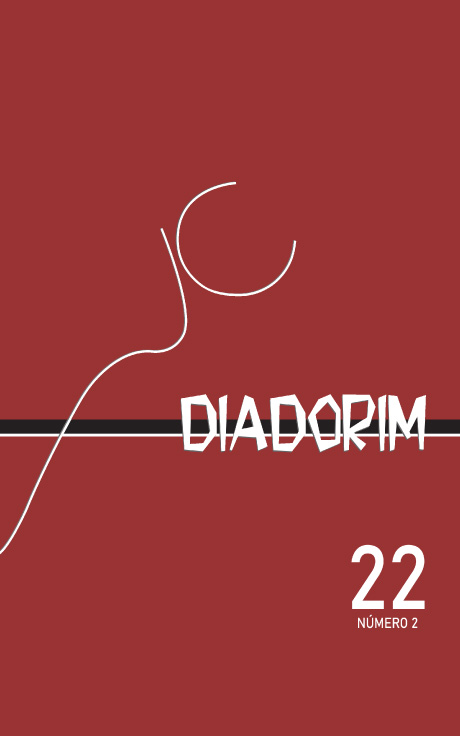The linguistic meaning in perspective
DOI:
https://doi.org/10.35520/diadorim.2020.v22n2a39463Palavras-chave:
Semântica Cognitiva, Semântica FormalResumo
This thematic review organized by Maria Lucia Leitão de Almeida, Ana Paula Quadros Gomes and Jorge Luiz Ferreira Lisboa Júnior is dedicated to Semantics.Referências
BARWISE, J.; COOPER, R.. Generalized quantifiers and natural language. In: Philosophy, language, and artificial intelligence. Springer, Dordrecht, 1981. p. 241-301.
BRASOVEANU, A.; RETT, J. Evaluativity across adjective and construction types: An experimental study. Journal of Linguistics. 2016.
CAMERON, L. Metaphor in educational discourse. A&C Black, 2003.
CASTILHO, A. T. de. O que se entende por língua e por gramática. 2ª versão do primeiro capítulo de Nova Gramática do Português Brasileiro, ms., 2015.
FAUCONNIER, G. Mental Spaces. Cambridge: Cambridge University Press, 1994.
______. Mappings in Thoughts and Language. Cambridge: Cambridge University Press. 1997.
______ ; TURNER, M. The Way we Think: Conceptual Blending and the Mind’s Hidden Complexities. New York: Basic Books, 2002.
______. Ten Lectures on Cognitive Construction of Meaning. Distinguished Lectures in Cognitive Linguistics. Leiden: Brill Books, 2018.
GEERAERTS, D. Theories of lexical semantics. Oxford University Press, 2010.
GOLDBERG, A. E. Constructions: A construction grammar approach to argument structure. University of Chicago Press, 1995.
______. Constructions at work: The nature of generalization in language. Oxford University Press on Demand, 2006.
HAMPTE, B. Embodiment and Discourse: Dimensions and Dynamics of Contemporary Metaphor Theory. In.: HAMPTE, B. (ed), Metaphor Embodied Cognition and Discourse. Cambridge: Cambridge University Press, 2017.
HOLMBERG, A. The syntax of answers to polar questions in English and Swedish. Lingua 128: 31-50. 2013. https://doi.org/10.1016/j.lingua.2012.10.018.
HOLMBERG, A. The syntax of yes and no. Oxford: Oxford University Press, 2016.
ILARI, R. Entrevista ao Professor Rodolfo Ilari. Revista Eletrônica de Linguística dos estudantes da Universidade do Porto. v. 7, n. 2. 2018.
KENNEDY, C.; MCNALLY, L. Scale structure, degree modification, and the semantics of gradable predicates. Language, p. 345-381, 2005.
LAKOFF, G. Women, fire, and dangerous things. Chicago: Chicago University Press. 1987.
______. The contemporary theory of metaphor. In: ORTONY, A. (Ed.). Metaphor and Thought. Cambridge: Cambridge University Press, 1993, p. 202-251.
LAKOFF, G; JOHNSON, M. Metaphors we live by. Chicago: Chicago University Press. 1980.
______. The metaphorical structure of the human conceptual system. Cognitive science, v. 4, n. 2, p. 195-208, 1980.
LANGACKER, R. W. Foundations of Cognitive Grammar, vol. 1, Theoretical Prerequisites. Stanford: Stanford University Press, 1987.
______. Foundations of Cognitive Grammar, vol. 2, Descriptive Application. Stanford: Stanford University Press, 1991.
______. Morphology in Cognitive Grammar. AUDRING, J.; MASINI, F. The Oxford Handbook of Morphological Theory, Oxford and New York: Oxford University Press. 2019.
MATTHEWSON, L. On the methodology of semantic fieldwork. International journal of American linguistics, v. 70, n. 4, p. 369-415, 2004.
MORAES DE CASTILHO, C. M. O Processo de redobramento sintático no português medieval. A formação das perífrases de estar. Campinas: Universidade Estadual de Campinas, Tese de doutoramento, 2005.
TALMY, L. Force dynamics in language and cognition. Cognitive science, v. 12, n. 1, p. 49-100, 1988.
______. TALMY, L. Towards a Cognitive Semantics. Vol. I: Concept Structuring Systems. Cambridge, Massachusetts, MIT Press, 2000a.
______. Towards a Cognitive Semantics. Vol. II: Typology and Process in Concepts Structuring. Cambridge, Massachusetts, MIT Press, 2000b.
VEALE, T. The ABCs of XYZs: Creativity and conservativity in humorous epithets. In.: MANJALY, J.; INDURKHYA, B. (eds.) Cognition, experience, and creativity. New Delhi: Orient Blackswan, 2014.
VENDLER, Z. Verbs and times. Philosophical Review, 56. 143–160, 1957.
ZWARTS, J. Prepositional aspect and the algebra of paths. Linguistics and philosophy, v. 28, n. 6, p. 739-779, 2005.
Downloads
Publicado
Edição
Seção
Licença
Transferência de direitos autorais - Autorização para publicação
Caso o artigo submetido seja aprovado para publicação, já fica acordado que o autor autoriza a UFRJ a reproduzi-lo e publicá-lo na Diadorim: Revista de Estudos Linguísticos e Literários, entendendo-se os termos "reprodução" e "publicação" conforme definição respectivamente dos incisos VI e I do artigo 5° da Lei 9610/98. O artigo poderá ser acessado pela internet, a título gratuito, para consulta e reprodução de exemplar do artigo para uso próprio de quem a consulta. Essa autorização de publicação não tem limitação de tempo, ficando a UFRJ responsável pela manutenção da identificação do autor do artigo.

A Revista Diadorim utiliza uma Licença Creative Commons Atribuição-NãoComercial 4.0 Internacional (CC BY-NC 4.0).

